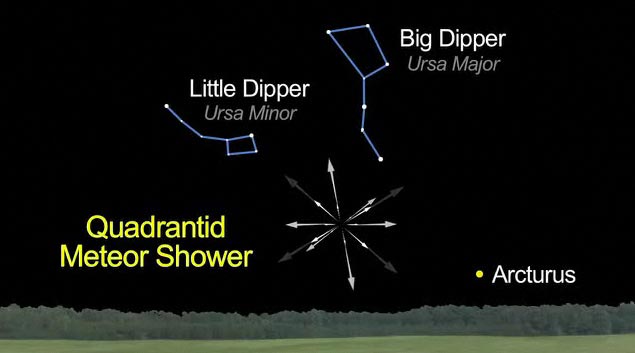Promising Quadrantid Meteor Shower to Peak Next Week

The year 2011 will begin with an eye-catching skyshow for well-placed observers when the annual Quadrantidmeteor shower hits its peak next week. The new yearpromises to be a great one to see the Quadrantidssince the moon, which can sometimes outshine the display, will be completelyout of the picture.
The Quadrantid meteor shower is due to reach maximum late Monday (Jan. 3) or early Tuesday (Jan. 4). Themoon will be in its "new" phase ? when it?s dark ? and poses noconcern of interfering with the meteor display.
This year, the most favorably placed skywatchersare expected to be in Europe and Central Asia. If predictions of the shower?speak come true, viewers there may spot 50 or 100 meteors per hour.
This Quadrantid meteor shower sky map shows where to look inthe northeastern sky to spot the shooting star display. It will appear betweenand below the familiar constellations of the Big Dipper and Little Dipper.
Meteor shower rings in 2011
In the United States, the predicted peak would come at 8p.m. EST on Jan. 3 (0100 GMT Jan. 4). With the meteors appearing to emanatefrom low on the horizon, viewers in the northern U.S. may see one dozen or twodozen Quadrantids per hour.
Very few meteors are likely to be seen in thesouthern United States, since they would be streaking from below the horizonduring the early hours of darkness.
Breaking space news, the latest updates on rocket launches, skywatching events and more!
Quadrantid meteors are of medium speed: slower than theLeonids and Perseids, yetfaster than the Geminids. They usually appear bluish,accompanied by fine, long spreading silver trains. [GreatLeonid meteor shower photos]
The peak of the "Quads" lasts only a few hours.But under ideal, dark-sky conditions, this can be one of the year?s best meteordisplays. (Any light pollution would cut down the numbers greatly.)
Give your eyes at least 15 to 20 minutes to adapt to thedark before starting a serious meteor count. No matter what time thepeak, you?d have to get up before dawn to see the best display.
This is because the shower's radiant ? from where themeteors appear to fan out or emanate ? is in QuadransMuralis, the Mural Quadrant, theobsolete constellation halfway between the head of Draco and the end of the BigDipper's handle.
An obsolete constellation is one that is no longerofficially recognized. That part of the sky is down low on the northern horizontill about midnight, rising slowly higher in the northeast toward dawn.
When and where to look
According to British meteor astronomer Alastair McBeath, the peak of the 2011 Quadrantidsmight occur roughly between 4 p.m. EST (2100 GMT) on Jan. 3 and 1 a.m. EST(0600 GMT) on Jan. 4. Most almanacs are highlighting 8 p.m. EST Jan. 3(0100 GMT Jan. 4) as the "most likely" time, because that is aboutwhen Earth is expected to pass through the densest part of this meteor stream,based on observations dating back to 1992.
But McBeath points out that other investigations have found that the Quadrantid rates can vary from year to year, so that itspeak timing may not be consistent.
If the 0100 prediction is correct, then the best chancesof seeing the peak of the 2011 Quadrantids would befor Europe east to central Asia, where the radiant will be rising in thenortheast during the morning hours of Jan. 4.
As a bonus, a partial solar eclipse will also be visibleat, or soon after sunrise.
For those living in North America, try looking for the Quadrantid meteors as soon as the sky gets dark on theevening of Monday, Jan. 3. The radiant will be low in the northwestduring the early evening. But even if you have excellent weather, the radiant will be very near the horizon.
If, however, the peak comes several hours later (asMcBeath suggests), viewers in eastern Canada and thenortheastern United States also might try looking toward the northeast part ofthe sky during the predawn hours of Jan. 4.
- Video ? Meteor Shower Kicks Off 2011 Skywatching Season
- Skywatchers Capture Gorgeous Photos of Geminid Meteor Shower
- The Best Leonid Meteor Shower Photos 1, 2, 3, 4
Joe Rao serves as aninstructor and guest lecturer at New York's Hayden Planetarium. He writes aboutastronomy for The New York Times and other publications, and he is also anon-camera meteorologist for News 12 Westchester, New York.
Join our Space Forums to keep talking space on the latest missions, night sky and more! And if you have a news tip, correction or comment, let us know at: community@space.com.

Joe Rao is Space.com's skywatching columnist, as well as a veteran meteorologist and eclipse chaser who also serves as an instructor and guest lecturer at New York's Hayden Planetarium. He writes about astronomy for Natural History magazine, Sky & Telescope and other publications. Joe is an 8-time Emmy-nominated meteorologist who served the Putnam Valley region of New York for over 21 years. You can find him on Twitter and YouTube tracking lunar and solar eclipses, meteor showers and more. To find out Joe's latest project, visit him on Twitter.
